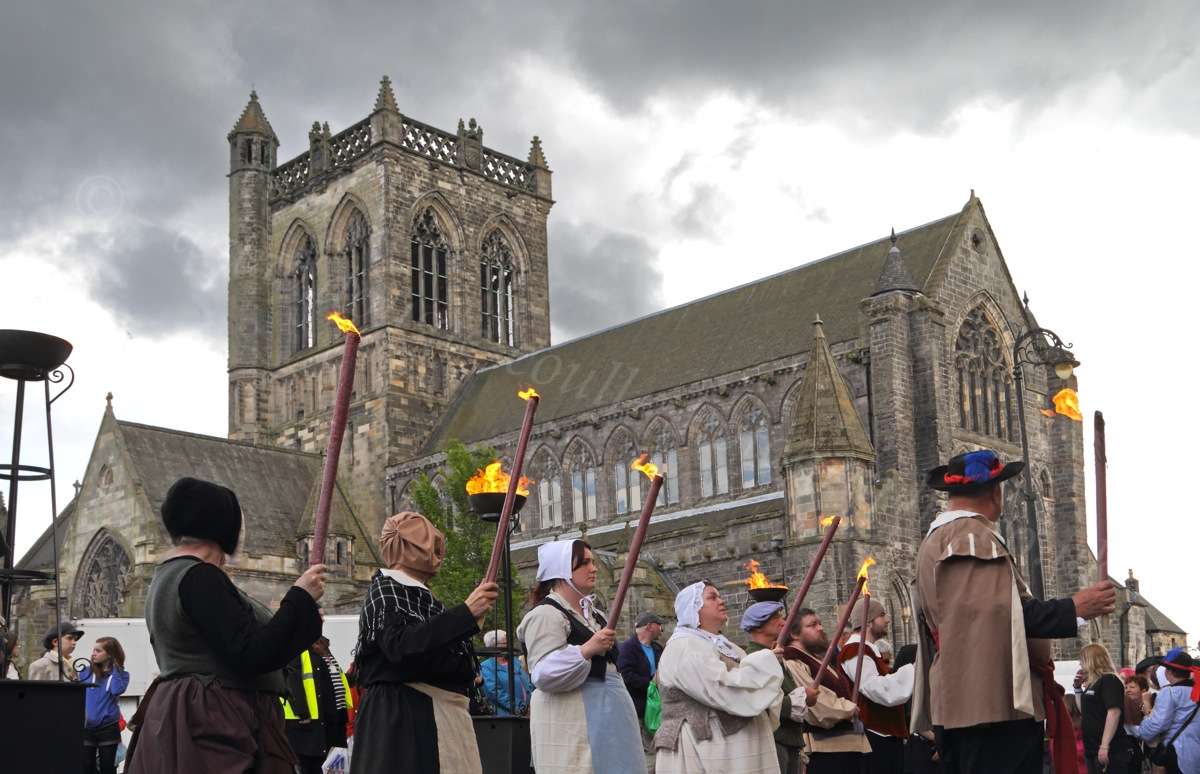
Re-enactment of Renfrewshire Witch Hunt of 1697
Contrary to conventional wisdom, witch hunting did not happen much during the Middle Ages, since in most places it was illegal to believe witches existed. Most of the witch hunts occurred during what’s called “the Renaissance.” Witch hunting continued though the “Age of Rationalism” and for the most part ended about in the middle of the “Age of Enlightenment” (in Europe at least).
As a general rule, witches were not hunted as witches, instead it fell under the larger banner of “heresy.” Pretty much what is going on now in targeting climatism unbelievers. Since suspected witches were tried as heretics instead of as witches, it makes getting exact numbers impossible. And so much for modern reasonable people being adverse to condemning and destroying others with differing beliefs.

Strange days have found us
Strange days have tracked us down
They’re going to destroy our casual joys
Lyrics from song “Strange Days”, The Doors 1967
The lyrics from the Doors classic song “Strange Days” seem (strangely) appropriate today with all of the lashing out of the climate alarmist movement. There are subpoenas flying around and multiple accusations against corporations, contrarian scientists, think tanks and even the federal government for not thinking and acting correctly to “fight climate change.”
Most recently we have the fires of hell awaiting all of us in the “Hothouse” earth depicted by climatists unless repentance occurs in the form of draconian reforms imposed by international self-appointed experts. As well we are now seeing warning labels on contrarian videos, a new step in pointing out modern witches (deniers).
Steven Hayward writes this week in a Powerline article Make Socialism Scientific Again with insights into what is going on (H/T John Ray) Of particular relevance is the excerpt below in italics with my bolds.
I’ve never met Prof. Clark, and don’t know him at all, but he is the author of one of my very favorite articles about the institutional problems of science and politics way back in 1980: “Witches, Floods, and Wonder Drugs: Historical Perspectives on Risk Management.” It’s a terrific article. It was the late columnist Warren Brookes who first brought it to my attention. Clark’s comparison of the institutional incentives for witch-hunting with contemporary risk assessment (built partially on the terrific work of the late Aaron Wildavsky) has a perfect application to today’s Malthusian environmentalism and especially climate change thermaggeddonism—especially apt for the Inquisition-like treatment of dissent from climate change orthodoxy.

Some samples from Clark’s article:
Collective action by the central authority was henceforth required, and any action taken against a particular individual was justified in the name of the common good. In the case of the witch hunts, this “common good” justified the carbonization of five hundred thousand individuals, the infliction of untold suffering, and the generation of a climate of fear and distrust—all in the name of the most elite and educated institution of the day. . .
The institutionalized efforts of the Church to control witches can be seen, in retrospect, to have led to witch proliferation. Early preaching against witchcraft and its evils almost certainly put the idea of witches into many a head which never would have imagined such things if left to its own devices. The harder the Inquisition looked, the bigger its staff, the stronger its motivation, the more witches it discovered. .
Since the resulting higher discovery rate of witch risks obviously justifies more search effort, the whole process becomes self-contained and self-amplifying, with no prospect of natural limitation based on some externally determined “objective” frequency of witch risks in the environment. . .
In witch hunting, accusation was tantamount to conviction. Acquittal was arbitrary, dependent on the flagging zeal of the prosecutor. It was always reversible if new evidence appeared. You couldn’t win, and you could only leave the game by losing. The Inquisition’s principal tool for identifying witches was torture. The accused was asked if she was a witch. If she said no, what else would you expect of a witch? So she was tortured until she confessed the truth. The Inquisitors justified ever more stringent tortures on the grounds that it would be prohibitively dangerous for a real witch to escape detection. Of course an innocent person would never confess to being a witch (a heretic with no prospects of salvation) under mere physical suffering. The few who lived through such tests were likely to spend the rest of their lives as physical or mental cripples. Most found it easier to give up and burn.
You can see here an early version of the “precautionary principle” (“The Inquisitors justified ever more stringent tortures on the grounds that it would be prohibitively dangerous for a real witch to escape detection”) and many other prominent traits of the climate campaign.

Here is Clark’s killer sentence:
Many of the risk assessment procedures used today are logically indistinguishable from those used by the Inquisition.
And this coda, for which you should swap out “risk assessors” with “climate change advocates”:
Today, anyone querying the zeal of the risk assessors is accused at least of callousness, in words almost identical to those used by the Malleusfive hundred years ago. The accused’s league with the devil against society is taken for granted. Persecution in the press, courts, and hearing rooms is unremitting, and even the weak rules of evidence advanced by the “science” of risk assessment are swept away in the heat of the chase. This is not to say that risks don’t exist, or that assessors are venal. It is to insist that skeptical, open inquiry remains theory rather than practice in the majority of today’s risk debates. That those debates are so often little more than self-deluding recitations of personal faith should not be surprising.
Cue the refrain that “97 percent of scientists believe in climate change.” Believe? It would seem the Inquisition never really went away: it just changed institutions and identified a different class of witches to hunt down.
Scientists are the equal of any other citizens, and are perfectly entitled to their political opinions. But to represent their opinions with the veneer of scientific authority, as is done here, degrades science, and contributes to the decline in public regard for the scientific community. Prof. Kerry Emanuel of MIT, a “mainstream” climate scientist, put the matter well a few years back:
Scientists are most effective when they provide sound, impartial advice, but their reputation for impartiality is severely compromised by the shocking lack of political diversity among American academics, who suffer from the kind of group-think that develops in cloistered cultures. Until this profound and well-documented intellectual homogeneity changes, scientists will be suspected of constituting a leftist think tank.
Instead of offering vague political nostrums like this article, scientists who are sincerely convinced of the high probability of doom from climate change ought to be offering the specs for the technical changes that need to be made to energy supply (i.e., what carbon intensities, what kind of pollution mitigation, what kind of “geoengineering” strategies, etc). To their credit, many scientists do just this. This group of authors clearly want to be in a different line of work—or at least ought to be.
Summary:
As climate alarmists continue to amp up the fear factor to achieve their political aims, they risk unleashing the heart of darkness hidden under the surface of civil society.
Background:
Perverse Postmodern Climate: Retreat from Reason
Head, Heart and Science Updated

For your real life Dilbert files-
https://www.wsj.com/articles/the-phony-numbers-behind-californias-solar-mandate-1534110302
LikeLike